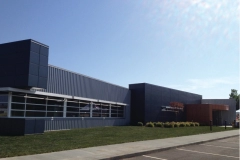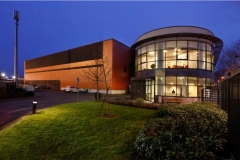Louisiana Data Centers Rely on Generators in Wake of Hurricane Ida
Louisiana Data Centers Rely on Generators in Wake of Hurricane Ida
In the aftermath of powerful Hurricane Ida, leading data center service providers in Louisiana continued operating, relying on backup generators to ride out widespread utility outages.
The deadly category 4 hurricane presents a more daunting challenge for companies with on-premise data centers in New Orleans, which could be without power for weeks following the “catastrophic failure” of the primary electric transmission towers serving the city. On Tuesday a data center in New Orleans City Hall briefly caught fire, disrupting city officials’ access to email and taking down a key web site offering emergency preparedness information
Utility provider Entergy hopes to restore power to some hospitals, nursing homes and emergency services by this evening, but many areas are facing an uncertain timeline for full recovery – perhaps as long as a month.
Hurricane Ida made landfall Sunday near Port Fourchon, Louisiana with sustained winds of 150 miles per hour and a storm surge bringing more than 10 feet of water onshore. More than 1 million residents lost power, and many areas are also without fresh water.
Commercial data centers operated by Venyu and EdgeConneX remained online throughout the storm, according to company executives.
“We started running on generators Sunday evening, and have been on them for more than 48 hours,” said Noah Boudreaux, General Manager of Venyu, a data center provider in Baton Rouge. “We have a fuel provider on-site, and we’ve had customers and other businesses reaching out to us to use our services and our business continuity center.”
“The power outlook is a little uncertain right now,” Boudreaux added. “Entergy is telling us that power should be back in the next day or so. They feel like they’re close, but it’s pretty rare that there’s an outage that lasts more than 24 hours.”
EdgeConneX remained online at its data center in Slidell, to the East of New Orleans, operating on generators until utility power was restored Tuesday. The facility stayed dry throughout, and wasn’t impacted by the flooding in Slidell.
The Challenges Facing New Orleans
For most residents in areas with no power, the immediate focus is on life safety issues and basic survival. Communications is an important element of that focus on life and safety, and access to data will matter in the recovery effort.
Tuesday’s fire at a third-floor data center at City Hall was put out quickly, but knocked out city websites including the main nola.gov web page and ready.nola.gov, where the city posts emergency updates. Officials said they are using social media and text messages to communicate essential updates to residents and businesses.
AT&T says its wireless network is recovering from widespread outages, and as of Tuesday evening was at 90 percent of normal capacity. The company has deployed 16 mobile satellite cell towers, with additional units on the way. “We understand how important it is to stay connected and will continue to work around the clock until all service is restored,” AT&T said on its Hurricane Ida update page.
New Orleans is not a major data center market, due in part to its disaster profile and the risk of hurricanes. The city experienced devastating flooding during Hurricane Katrina in 2005, and Louisiana experienced three hurricane landfalls (Laura, Delta and Zeta) in 2020. But several providers serve the local business community, offering disaster recovery and business continuity services, as well as content distribution.
Energy Infrastructure Battered by Storm
Venyu, a division of Eatel Corp., has been serving Louisiana since 2001 and has two data centers in Baton Rouge and a Tier III facility upstate in Shreveport. The company is battle tested in major storms, with a strong focus on disaster recovery services. During Hurricane Katrina, Venyu was an early user of virtualization for offsite backup and recovery.
But Ida was not a normal storm. Fed by warm waters in the Gulf of Mexico, Ida strengthened from a tropical storm to a Category 4 hurricane in about 72 hours.
“This storm was headed directly for Baton Rouge and then at the last minute, it jogged a little bit to the east,” said Boudreaux. “It could have been much worse here. We’re dealing with the usual challenges with the power beating being out and some access issues. But it’s not the same for some of our customers and colleagues, to the east and south in New Orleans. We have customers in all of those locations, and they may be without power for some time.”
Hurricane Ida wreaked havoc on the power infrastructure serving the New Orleans area. Entergy reported storm damage on 208 transmission lines, 216 substations, 550 transformers and 2,438 poles, the company said Monday. Over 1,800 miles of transmission lines remain out of service, including those served by a high-capacity transmission tower in Avondale that collapsed during the storm.
“At 150 mph, Hurricane Ida’s winds were incredibly devastating,” said Phillip May, Entergy Louisiana president and CEO. “We continue looking at options to restore power to those parishes that are out.”
Entergy said it has secured 10 backup generator units for the Sewerage and Water Board and a generator at the New Orleans Convention Center. Its initial restoration plan for New Orleans involves a short-term focus on the city’s hospitals, many of which are at capacity caring for COVID-19 patients, including many on ventilators. One approach being considered is an “island” strategy that would create an isolated grid for New Orleans using local generation while Entergy conducts repairs to the damaged transmission lines to reconnect the city to the regional grid.
Helping Companies Recover
Venyu said it stands ready to assist Louisiana companies in their recovery efforts. One of the company’s Baton Rouge sites features a 2,500-square-foot business continuity center with workstations, Internet access and even a kitchen and showers, enabling businesses to operate remotely.
“We’ve had customers and other businesses reaching out to us to use our services and our business continuity center,” said Boudreaux. “We’re about 25% occupied and we’re starting to hear from more folks. It could be that they might need it for a week, a month or three months … we just don’t know right now.
“Right now I think people are still trying to figure out what to do,” Boudreaux added. “We expect to see a lot more people migrating their operations, and we want to be there to support them. I don’t think the influx has really hit yet. There were more inquiries today than we had yesterday from people that need help, and I expect we’ll see more tomorrow and through the rest of the week. Smaller companies often don’t know what their options are, and we help them understand that.”

Backup generators at a Venyu data center in Baton Rouge. (Photo: Venyu)
A pattern seen on both Hurricane Karina and Hurricane Harvey in Houston in 2017 is that commercial data center providers saw strong demand after the storm from companies that experienced problems with their on-premises data centers.
One of the lessons from Katrina and other regional disasters is the critical importance of diesel fuel to support emergency generators. Venyu had a fuel supplier on-site in Baton Rouge to manage resupply should it need additional fuel.
“Our fuel provider has a service that provides a dedicated driver and fuel truck,” said Boudreaux. “It’s an out of state company and we decided to do that as an additional precaution in case our local providers were affected by an event.”
A key part of a data center emergency operations plan is looking after staff that may need to remain at the data center for an extended period of time, even as a major storm threatens the area where they live.
“You have to be prepared to be away and to be sure that your family is secure,” said Boudreaux. “Our folks usually make sure that their families are relocated prior to any event. We have to make sure they’re in good shape, so they can feel comfortable about being able to focus on work. We have to deal with this a lot. We see a lot of these natural events, and it gives us experience that only a few data centers have. We’ve learned to be as agile as possible.”
More >> Louisiana Data Centers Rely on Generators in Wake of Hurricane Ida


